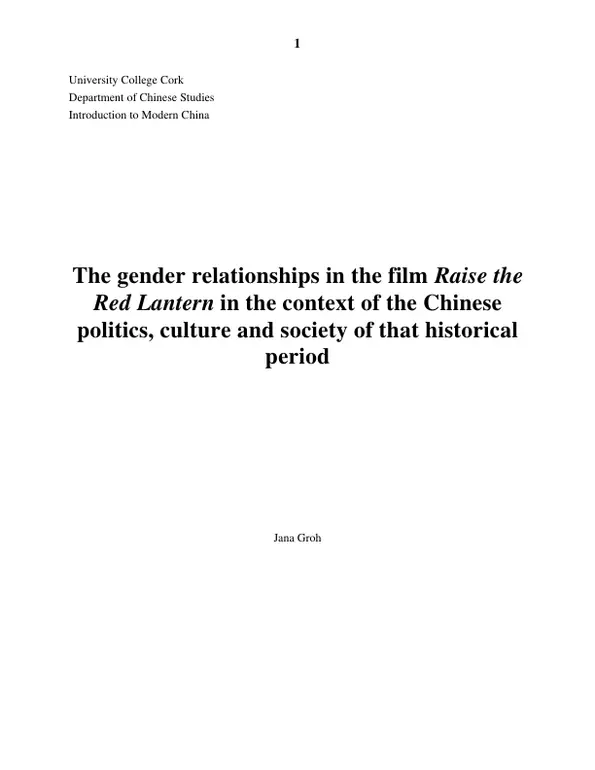At the beginning of the twentieth century China experienced many changes in nearly every respect. The country transformed into a modern state and in doing so traditions changed as well. For example China changed its form of government by abolishing its empire and establishing a republic. The old imperial regime was seen as very old-fashioned: „un monde que la technique et les idées modernes n‘ont pas encore touché“ (Bauchau, 1982, p. 19; translation: a world which has not yet been touched by the modern technic and ideas). If China wanted to be part of the modern westernised world, it had to modernise itself. But even though the last emperor abdicated in 1912, many traditions still lived in the Republic of China, some until the 1940s (cf. Brugger, 1977, p. 20). This can be seen in the Chinese film „Raise the Red Lantern“. This movie which original title is „Dà hóng denglóng gaogaou gua“ was made by the fifth generation director Zhang Yimou, and was published in 1991. The film set in the 1920s is about the young woman Songlian who actually has studied at university for one year. When her father dies, she cannot afford going to university any longer. Her stepmother marries her off to a rich man, Chen Zuoqian, in whose household traditions are most important. Songlian becomes the fourth concubine of this man. Every evening red lanterns are being hung up in the quarter of that wife who Chen Zuoqian is going to spend the night with. This also means that the respective wife seems to be the favourite one so that she gets more power over the whole family, e.g. she can decide about the dishes. Thus the four women, who see each other as rivals, fight each other whenever they can. Songlian tries to struggle hard for a place in the family, but she somehow fails. In the end she causes the death of two people, of her servant Yan‘er and of the third concubine Meishan, so that she finally gets insane.
In this film one can watch the traditional Chinese gender relationships. These are analysed more closely in this essay.
Inhaltsverzeichnis (Table of Contents)
- The gender relationships in the film Raise the Red Lantern in the context of the Chinese politics, culture and society of that historical period
- Introduction
- The Traditional Chinese Gender Relationships and the Family
- Confucianism and Traditional Chinese Society
- Concubinage, Patrilocal and Patrilineal Principle
- The Changing Role of Women
- The Chinese New Culture Movement
- The May Fourth Movement
- The New Education System
- Conclusion
Zielsetzung und Themenschwerpunkte (Objectives and Key Themes)
This paper aims to examine the portrayal of gender relationships in Zhang Yimou's film "Raise the Red Lantern" and contextualize these depictions within the broader framework of Chinese politics, culture, and society during the 1920s. By exploring the film's portrayal of traditional Chinese values, the paper aims to shed light on the changing dynamics of gender roles and social structures during a pivotal period of transition in China.
- Traditional Chinese Gender Roles and Hierarchy
- The Influence of Confucianism on Gender Relations
- The Role of Concubinage and Patriarchy in Chinese Society
- The Rise of the New Culture Movement and its Impact on Women's Rights
- The Development of a Modern Education System and its Impact on Women's Literacy
Zusammenfassung der Kapitel (Chapter Summaries)
- This chapter introduces the context of the film "Raise the Red Lantern" and discusses the historical backdrop of the 1920s in China, highlighting the country's transformation from a traditional to a modern state. The chapter explores the impact of this transition on traditional Chinese gender relationships and social structures.
- This chapter analyzes the traditional Chinese gender relationships as depicted in "Raise the Red Lantern". It examines the power dynamics within the family, highlighting the dominance of the male head of household and the subordinate roles assigned to women.
- This chapter explores the influence of Confucianism on the traditional Chinese social system and its impact on gender relations. It discusses the hierarchical structure of society and the inherent power imbalances that it reinforced.
- This chapter delves into the practice of concubinage in traditional China and its connection to the patrilocal and patrilineal principles. It examines how these practices further entrenched the power of men and limited the opportunities for women.
- This chapter explores the changing role of women in Chinese society, focusing on the emergence of the New Culture Movement and its challenge to traditional values. It examines the movement's advocacy for democracy and its impact on women's rights.
- This chapter discusses the May Fourth Movement and its contribution to the broader discourse on women's rights. It highlights the movement's role in challenging traditional social norms and its call for a more equitable society.
- This chapter analyzes the development of a modern education system in China and its impact on women's literacy. It contrasts the traditional educational system with the new system and explores its implications for gender equality.
Schlüsselwörter (Keywords)
This paper focuses on the interplay between gender relations, traditional Chinese values, and social structures in the context of the 1920s. Key themes include the influence of Confucianism, the practice of concubinage, the rise of the New Culture Movement, and the development of a modern education system. The film "Raise the Red Lantern" serves as a primary case study to explore these concepts and their impact on the lives of women in traditional China.
- Arbeit zitieren
- Jana Groh (Autor:in), 2006, The gender relationships in the film 'Raise the Red Lantern' in the context of the Chinese politics, culture and society of that historical period, München, GRIN Verlag, https://www.grin.com/document/80831


